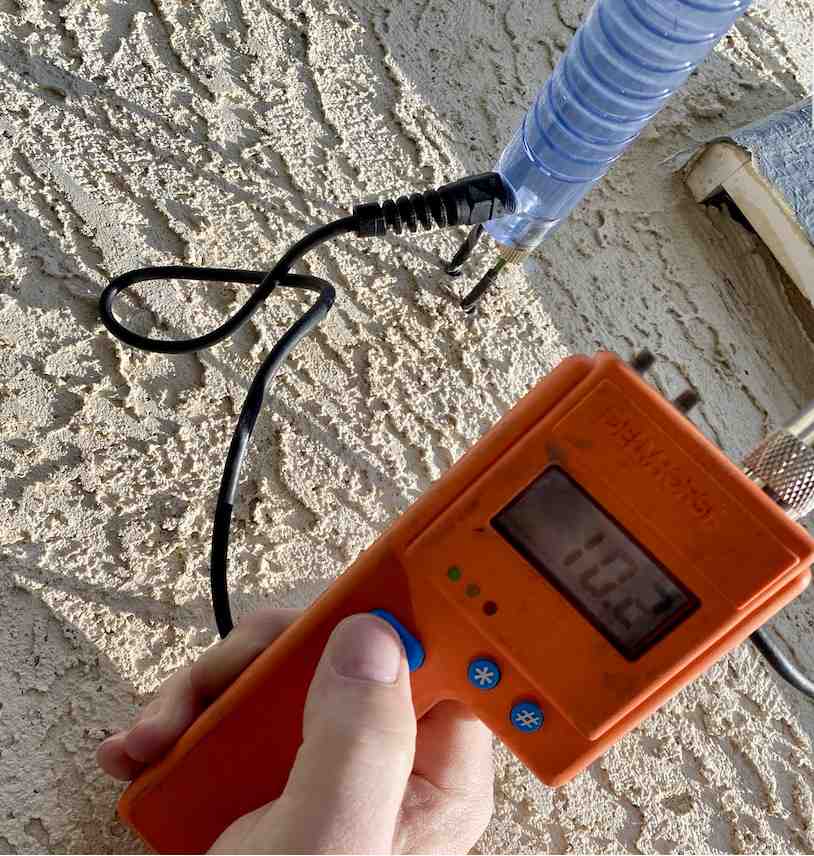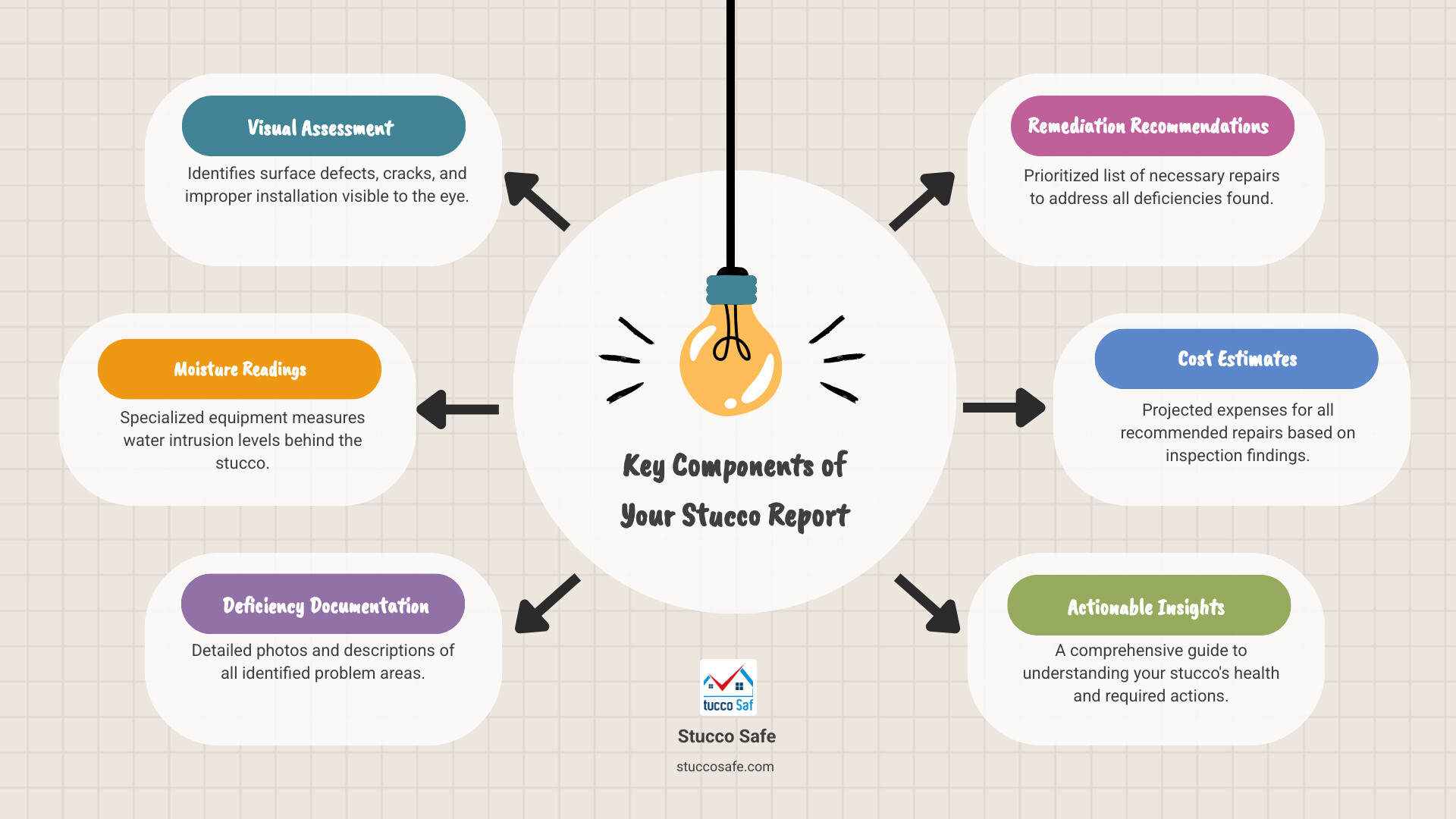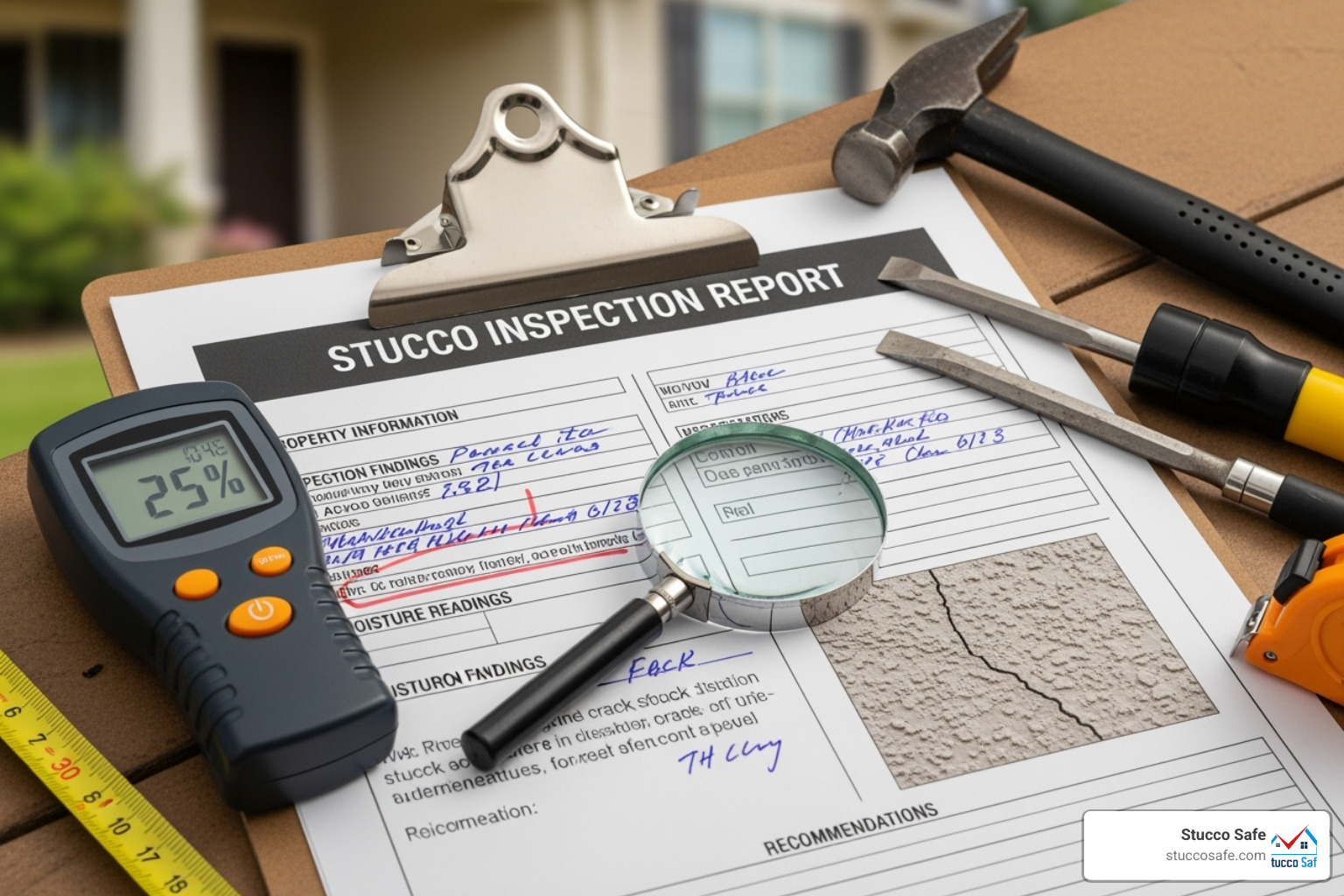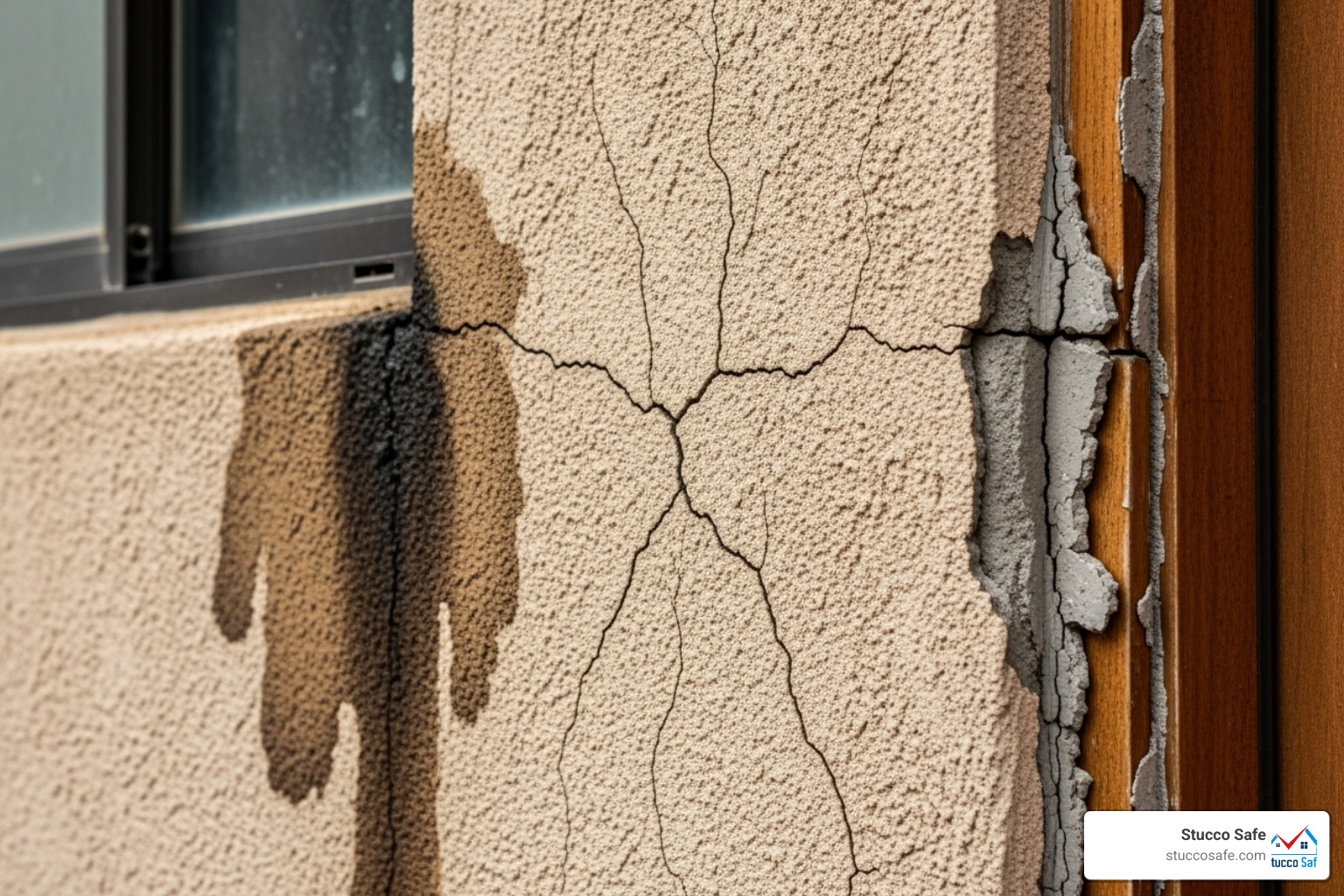Stucco Inspection Report: Decode Safely 2025
Why Understanding Your Stucco Inspection Report Matters
A stucco inspection report is a detailed document that identifies moisture problems, structural deficiencies, and damage in your home’s stucco system. Here’s what you need to know:
What a stucco inspection report includes:
- Visual assessment – Surface defects, cracks, and improper installation
- Moisture readings – Water intrusion levels measured with specialized equipment
- Deficiency documentation – Problem areas with photos and descriptions
- Remediation recommendations – Required repairs ranked by priority
- Cost estimates – Expected repair expenses based on findings
Most homeowners receive their stucco inspection report feeling overwhelmed by technical terms, moisture readings, and repair recommendations. You’re not alone.
The report in your hands could reveal hidden water damage that threatens your home’s structural integrity – or it might give you peace of mind that everything is sound. Either way, understanding what the inspector found is critical to protecting your investment.
Moisture problems don’t announce themselves. By the time you see stains or cracks on the surface, water may have been causing damage behind your walls for months or years. That’s why stucco inspections typically range from $495 to $1,595 or more for very large homes – the thorough investigation is worth every penny compared to the tens of thousands you might spend on undetected damage.
I’m Gabe Kesslick, and I’ve been conducting stucco inspections and interpreting stucco inspection reports since 2001. With certifications including EDI Level 2 Certified Stucco Inspector and BESI Level 2 Certified Building Envelope Forensic Inspector, I’ve helped hundreds of homeowners understand exactly what their reports mean and what actions they need to take.
Understanding Stucco Inspection Reports
Think of a stucco inspection report as a complete physical exam for your home’s exterior. When we arrive at your property, we’re not just glancing at the walls and calling it a day. We’re conducting a systematic investigation designed to uncover problems you can see and the ones you can’t.
The inspection process follows a logical progression, starting with what’s visible on the surface and moving deeper as needed. We’re detectives on a mission, looking for clues that tell us whether water has found its way behind your stucco. Because here’s the thing: stucco itself is remarkably durable, but when moisture gets trapped behind it, that’s when the real trouble begins.
Moisture readings are the foundation of every thorough inspection. Water is stucco’s worst enemy. When it sneaks behind the surface through improper installation, failed caulking, or missing flashing, it can sit there quietly causing rot, mold, and structural damage for years before you notice anything wrong on the outside. Our specialized equipment lets us detect these hidden moisture pockets long before they turn into expensive disasters.
Every deficiency we find gets carefully documented in your report. You’ll receive a detailed account complete with photos, precise descriptions, and sometimes thermal imaging that shows exactly what’s happening behind your walls. This isn’t just a laundry list of problems – it’s a clear roadmap showing you what’s wrong, why it matters, and what needs to happen next. We believe in transparency, which means you’ll understand exactly what you’re dealing with.
Key Components of a Stucco Inspection Report
A comprehensive stucco inspection report builds your home’s story through three distinct phases of examination. Each layer reveals more detail, and together they create a complete picture of your exterior’s health.
The visual inspection is where we begin. We walk around your entire property with a trained eye, looking for telltale signs that might indicate trouble brewing beneath the surface. We examine every crack, every area of discoloration, and any white powdery residue (called efflorescence) that signals water movement. We pay special attention to the areas where water likes to sneak in – around windows, doors, and rooflines. We check whether your home has proper flashing, kick-out diverters, and correctly installed weep screed. Think of this phase as gathering evidence before we bring out the high-tech detective tools.
The non-invasive inspection takes things deeper without causing any damage. This is where our specialized electronic moisture meters come into play. We systematically scan the critical areas where water typically infiltrates – around every window and door, near penetrations like hose bibs and electrical outlets, and along the base of your walls. These meters can detect liftd moisture levels behind the stucco without drilling a single hole. It’s almost like having X-ray vision, showing us where moisture might be hiding and guiding us to the spots that need closer examination.
The invasive inspection provides definitive answers. If our non-invasive readings indicate liftd moisture, we’ll recommend this more thorough forensic testing method. With your permission, we carefully drill small holes (just 3/16 inch in diameter) into the suspected areas. Through these tiny openings, we insert probes that measure the actual moisture content of the wood sheathing and framing behind your stucco. This step is crucial because it moves us from “there might be a problem” to “here’s exactly what’s happening.” These readings tell us whether water has penetrated the system and how severe any damage might be. Afterward, we carefully seal these small holes so they’re barely noticeable. To learn more about our process, check out what is involved in a stucco inspection.
Interpreting Moisture Readings
The moisture readings in your stucco inspection report tell the real story of what’s happening behind your walls. Understanding these numbers is essential to grasping whether you’re dealing with a minor concern or a serious problem.
Moisture levels are typically expressed as percentages. Generally speaking, readings below 15-20% indicate dry, healthy conditions – exactly what you want to see. When readings climb above this range, especially exceeding 25-30%, that’s when alarm bells start ringing. These liftd numbers signal active water intrusion that can lead to rot, mold, and structural damage if left unchecked.
During an invasive inspection, we take what we call “lift readings.” This forensic testing method involves drilling those small probe holes and inserting moisture meters directly against the wood sheathing and framing behind your stucco. These readings are highly accurate and provide definitive proof of whether moisture has penetrated your home’s envelope. A lift reading of 20% or higher is typically a red flag, indicating that water has breached the stucco system and is affecting the structural components of your home.
When we find significant moisture, remediation becomes necessary. Your report will include clear, prioritized recommendations for addressing the water intrusion. This isn’t about slapping on a quick patch and hoping for the best. Proper remediation means identifying and fixing the root cause – whether that’s repairing flashing, re-caulking joints, or in more severe cases, removing and replacing sections of stucco to repair damaged sheathing or framing underneath. We rank these recommendations by urgency, so you’ll know what needs immediate attention and what can potentially wait.
The goal is always the same: stop the water from getting in, repair any damage it’s already caused, and protect your home from future moisture problems.
Importance of Regular Stucco Inspections
Here’s something most homeowners don’t realize until it’s too late: by the time you notice something wrong with your stucco, the real damage has often been happening for years.
That’s exactly why we’re such strong advocates for regular stucco inspections. Think of it as preventative care for your home’s exterior – you wouldn’t skip your annual physical, right? The same principle applies to your stucco. These routine checks are one of the most effective preventative measures you can take to protect your investment and your wallet.
The truth is, water damage doesn’t happen overnight. A small gap in the caulking or a tiny crack near a window might seem harmless on the surface, but behind your walls, moisture can be quietly soaking into wood sheathing and framing. We’ve walked into homes where everything looked fine from the outside, only to find extensive rot and damage that had been silently spreading for five or more years. The homeowners had no idea – until the repair bills started climbing into the tens of thousands.
This hidden damage is particularly insidious because stucco is so good at hiding it. Your walls might look perfectly fine while moisture is trapped behind them, creating the perfect environment for wood rot and mold growth. That’s the real danger: what you can’t see is often far worse than what you can.
Regular inspections protect your home’s structural integrity in a very real way. The wood components behind your stucco aren’t just decorative – they’re literally holding your house together. When moisture compromises these structural elements, you’re not just dealing with cosmetic issues. You’re looking at potential safety concerns and expensive repairs that go far beyond the stucco itself.
A comprehensive stucco inspection report gives you the power to catch these problems early, when they’re still manageable and affordable to fix. It’s not about being paranoid – it’s about being smart.
How Often Should Stucco Be Inspected?
The question we hear most often is: “How frequently should I actually have my stucco inspected?”
For most homes, we recommend a thorough professional inspection every 3 to 5 years. This timeframe works well for established homes, especially those that are more than 10 years old or located in areas that get significant rainfall. Regular monitoring at this interval gives us a chance to spot developing issues before they become serious problems.
That said, timing isn’t one-size-fits-all. If you’re in the process of buying or selling a home with stucco, an inspection should be non-negotiable, regardless of the home’s age. It’s simply too risky to assume everything is fine without professional verification.
There are also situations that call for more frequent attention. If your area has just been hit by severe storms, heavy winds, or hail, it’s worth scheduling an inspection sooner rather than waiting for your regular interval. The same goes if you notice any changes to your stucco’s appearance – new cracks, stains, or other concerning signs warrant immediate professional attention.
Damage prevention is always more cost-effective than damage repair. When you consider that a thorough inspection might cost between $495 and $1,595, and compare that to potential repair bills that can easily reach $30,000 or more, the math becomes pretty clear. For more specific guidance on inspection timing, you can explore how often do you need to inspect stucco.
Signs of Stucco Damage
Your home is actually pretty good at communicating when something’s wrong with its stucco – you just need to know what to listen for. Catching these warning signs early can mean the difference between a simple repair and a major renovation project.
Cracking is probably the most obvious sign, but not all cracks tell the same story. Tiny hairline cracks are often just surface-level and cosmetic, caused by normal settling or temperature changes. What should get your attention are the larger, more dramatic cracks – think spiderweb patterns, long horizontal or vertical splits, or cracks that seem to be growing over time. Pay special attention to cracking around windows, doors, and corners, as these are prime spots for water to sneak in.
Discoloration on your stucco is your home waving a red flag. Dark streaks, stains, or patches usually mean water has been finding its way where it shouldn’t be. Green or black staining? That’s often algae or mildew throwing a party on your damp walls. And if you notice a white, chalky powder on the surface – that’s efflorescence, which happens when moisture moves through the stucco and leaves salt deposits behind. None of these are things you want to ignore.
Then there are caulking issues, which might seem minor but can cause major headaches. The caulk around your windows, doors, and any penetrations in your stucco acts as your first line of defense against water intrusion. When that caulk starts cracking, shrinking, or falling out entirely, it’s essentially leaving the door wide open for moisture to get behind your stucco. We see this all the time, and it’s one of the most common entry points for the water damage we find during inspections.
If you’re seeing any of these warning signs, don’t wait. Get a professional to take a closer look. For a more detailed breakdown of what to watch for, check out how do you know if your stucco is bad.
Costs and Considerations for Stucco Inspections
Let’s talk money – because we know that’s probably one of your first questions. A professional stucco inspection typically ranges from $495 to $1,595 or more for very large homes. I get it, that might make you wince a little. But here’s the thing: this investment is genuinely tiny compared to what you’d face if hidden moisture damage goes undetected for years.
Think about it this way – if you found rot in your wall framing that’s been festering for five years, you could be looking at repair bills in the tens of thousands of dollars. Suddenly, that inspection fee looks pretty reasonable, right? It’s like paying for an oil change versus replacing your entire engine.
Several things influence where your inspection falls in that price range. The size of your home is the biggest factor – a 1,500 square foot rancher takes considerably less time than a 4,000 square foot two-story with complex architectural features. The complexity of your exterior also matters. If you’ve got multiple levels, lots of decorative details, or areas that are tough to access, that adds time and effort to the inspection process.
The type of inspection you need affects the cost too. A straightforward non-invasive scan with moisture meters is on the lower end of the spectrum. If our initial readings suggest problems and we need to perform invasive testing with probe holes to get definitive answers, that requires additional time and specialized forensic testing equipment. But that precision is exactly what gives you the accurate results you need to make informed decisions about your home.
Hiring a Certified Stucco Inspector
Here’s where things get really important – not all inspectors are created equal. When you’re trusting someone to evaluate your home’s structural health, you want the real deal, not someone who just bought a moisture meter last week.
Certification matters. A lot. When an inspector holds credentials from organizations like the Exterior Design Institute (EDI) or BESI (Building Envelope Science Institute), you’re not just getting a piece of paper to hang on the wall. These certifications mean the inspector has gone through rigorous training, passed comprehensive exams, and demonstrated a thorough understanding of stucco systems, moisture dynamics, and forensic testing methodologies. It’s the difference between someone who knows stucco and someone who really knows stucco.
Experience is equally crucial. I’ve been conducting stucco inspections since 2001, and I can tell you that every home teaches you something new. An experienced inspector has seen hundreds of different scenarios – from subtle moisture patterns to catastrophic failures – and knows exactly what to look for. They understand how different stucco systems behave, how water moves through building assemblies, and what those moisture readings actually mean in the real world. They’ve developed an eye for the small details that less experienced inspectors might overlook.
When you hire a certified, experienced professional, you’re getting more than just numbers on a page. You’re getting someone who can interpret those findings within the context of your specific home, your local climate, and your construction type. The stucco inspection report you receive becomes a comprehensive roadmap, not just a confusing collection of technical jargon. That’s the level of expertise and accuracy you deserve when protecting your most valuable investment.
Frequently Asked Questions about Stucco Inspection Reports
You’ve probably got questions swirling around your head about stucco inspections – and that’s completely normal. Over the years, we’ve heard many of the same concerns from homeowners who are trying to protect their investment and understand what’s really going on with their home’s exterior. Let me walk you through the most common questions we get.
What is involved in a stucco inspection?
When you schedule a stucco inspection with us, you’re getting a thorough, multi-layered investigation of your home’s exterior health. We start with a careful visual assessment, walking around your entire property to examine every inch of stucco. We’re looking for cracks, stains, improper installation details, and any visible red flags that might indicate trouble brewing beneath the surface.
Then we move to our non-invasive testing phase, where we break out the specialized moisture meters. These electronic tools let us scan critical areas – around windows, doors, penetrations, and the base of walls – to detect liftd moisture levels without causing any damage to your home. Think of it like a metal detector, but for water problems.
If those initial readings show cause for concern, we’ll recommend invasive testing. This involves drilling tiny, barely noticeable holes (about 3/16 inch) into the stucco so we can insert probes directly to the wood sheathing and framing behind it. These “lift readings” give us definitive answers about whether moisture is trapped and causing damage. After testing, we seal these holes carefully.
Everything we find gets documented with photos, detailed descriptions, and precise moisture readings. The result is your comprehensive stucco inspection report, complete with prioritized remediation recommendations and cost estimates. For a more detailed breakdown of our process, visit what is involved in a stucco inspection.
How do you know if your stucco is bad?
Your home will often give you hints when something’s wrong with its stucco – you just need to know what to look for. The most obvious warning sign is cracking, especially when you see large cracks, long horizontal or vertical splits, or those spiderweb patterns that seem to spread across the surface. Hairline cracks might not be a big deal, but substantial cracking usually means something more serious is happening.
Discoloration is another major tell. Dark stains, streaks, or patches often indicate water intrusion or mold growth lurking behind the surface. If you notice green or black staining, that’s typically algae or mildew thriving in damp conditions. White powdery residue, called efflorescence, means moisture is moving through your stucco and leaving salt deposits behind – not a good sign.
Don’t overlook caulking issues either. The caulk around your windows, doors, and other penetrations is your first line of defense against water. When it’s cracked, shrunk, or missing entirely, water has an easy path behind your stucco. You might also notice soft spots, bulging areas, or sections of stucco that sound hollow when tapped.
If you’re seeing any of these warning signs, it’s time to call in a professional. We can determine whether what you’re seeing is just cosmetic or if there’s hidden damage that needs attention. Learn more about identifying problems at how do you know if your stucco is bad.
How often do you need to inspect stucco?
The general rule of thumb we recommend is a professional stucco inspection every 3 to 5 years, particularly if your home is more than a decade old or you live in an area that gets a lot of rain. Regular inspections are like routine maintenance – they catch small problems before they become expensive disasters.
That said, certain situations call for an inspection sooner. If you’re buying or selling a home with stucco, an inspection is absolutely essential, regardless of the home’s age. You don’t want any surprises after closing day. Similarly, if you’ve recently experienced severe storms, noticed new cracks or stains, or had any exterior renovations or repairs, it’s smart to schedule an inspection right away.
The cost of a regular inspection – typically ranging from $495 to $1,595 or more for very large homes – is a small price to pay compared to the tens of thousands you might spend on major repairs if problems go undetected. Proactive inspections protect your home’s structural integrity and your financial investment. For specific guidance on timing, check out how often do you need to inspect stucco.
Conclusion
You’ve made it through your stucco inspection report, and hopefully, you’re feeling a lot less overwhelmed than when you started. Understanding what’s in that report isn’t just about deciphering technical terms or moisture percentages—it’s about taking charge of your home’s future. When you know what’s happening behind those walls, you can make smart decisions that protect both your family and your investment.
We get it. Nobody wakes up excited about stucco inspections. But here’s the thing: knowledge really is power when it comes to your home. A clear understanding of your report means you can address small issues before they turn into wallet-draining nightmares. It means you can sleep better knowing exactly what’s going on with your home’s exterior. And it means you’re not left wondering “what if?” years down the road.
At Stucco Safe, we’ve dedicated ourselves to making this whole process as straightforward and stress-free as possible. Since 2001, we’ve been helping homeowners throughout Southeastern Pennsylvania, New Jersey, and Delaware—from Philadelphia to West Chester, Cherry Hill to Wilmington—understand exactly what their stucco is trying to tell them. Our forensic testing methods and certified inspectors aren’t just fancy credentials; they’re your assurance that you’re getting the most accurate picture of your home’s health.
Whether you’re a nervous first-time home buyer trying to make sense of your pre-purchase inspection, or a longtime homeowner who’s noticed some concerning cracks, we’re here for you. Our professional stucco inspection and testing services are designed to give you clear answers, not confusing jargon. We believe every homeowner deserves to understand their inspection results without needing an engineering degree.
Don’t let hidden moisture become that expensive surprise you could have prevented. Your home is likely your biggest investment—it deserves the protection that comes from regular, professional inspections and clear, honest reporting. Let us help you understand what’s really going on behind your stucco, so you can take the right steps to keep your home safe, sound, and beautiful for years to come.




